If you’re a B2B software/tech company, how do you go from traction to scale?
That’s a big question that can’t be answered in one, single blog post, but the start of a solution comes down to:
- Your existing team and structure.
- Your existing systems and processes for attraction, acquisition, retention, and growth.
- Your marketing and sales vision, and how your team is formed to execute on that vision.
There are a few more points that I’ll leave for now, but that’s where you need to begin.
Now, whether your team consists of 1 or 10, and anything in-between, before you start publishing lead magnets (whitepapers), populate your site with landing pages, and push PPC in classic omni-channel flair…
…You will waste a lot of resources, time, and team member talent if you haven’t structured your team for scale.
Models, frameworks, strategies, processes, and tactics are crucial – but they serve your vision for growth and team model.
The Right Team Model Comes From Mining Your Existing Platform For Insights
You start noticing trends when you’re immersed within a specific market and solving a specific problem.
If a B2B software/tech company is in that growth phase stage, and they’re looking for scale, there are a few core concepts (the 80/20, if you will) that will make the biggest, exponential difference in terms of scale velocity and volume.
I’ve been helping companies with demand generation for the past couple of years now, by blending what’s working with inbound, outbound, and implementing marketing automation.
Often, the first constraint to growth we need to deal with has to do with their existing team model as well as systems and processes for marketing and sales.
You don’t need a full, complete overhaul, but some tweaks are required and you often need to formalize processes at that point.
If your team and systems aren’t setup for scale, you won’t achieve scale, no matter how many “hacks” you try.
The first place to start is re-modeling your team – again, you only need to make tweaks when you’re in the traction stage and looking for growth. Your business should be flexible enough to withstand eliminating bad practices and implementing what will work.
So, let’s take a look at traditional and typical marketing team structures.
The Typical Marketing Team Structures You’ll Come Across
There are, of course, variations on these, but often you’ll see these as the foundation for other team configurations.
1. The Traditional Team Model
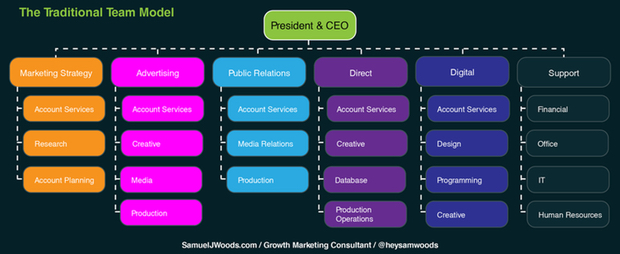
Factors for it to be successful:
- Drop the politics.
- Business and financial objectives need to be complimentary.
- Disciplined approach to process.
When to use it:
- When you have large and separate divisions.
- Little need for cross-client sharing.
Issues this structure addresses:
- Clear line of authority.
- Defined career path and opportunities.
- Focused on the best capabilities.
Potential problems created by this structure:
- Agency and structure comes first, and clients tend to end up second.
- The division can create redundant functions; drop in effectiveness.
- An “impersonal” structure can stifle innovation and ideas.
2. The Integrated Team Model
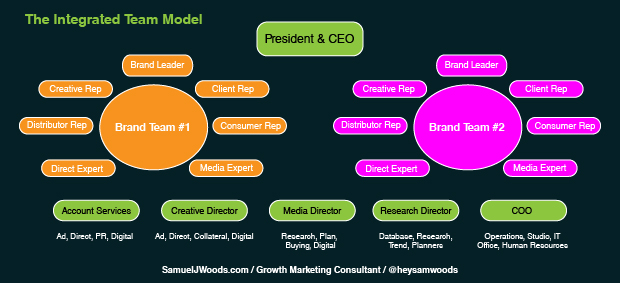
Factors for it to be successful:
- Requires talent to take advantage of integration.
- Deference to functions and departments; one person is not above the team.
- Generous compensation plans.
When to use it:
- Clients requires brand servicing.
- You have large and complex accounts.
- Unified voice is more important than execution.
Issues this structure addresses:
- Remove divisional barriers amongst functions and teams.
- Enables more “intimate” client relationships.
Potential problems created by this structure:
- Conflicting priorities and leadership.
- You need to maintain high performance on output.
- Maintaining an effective balance between strategy and tactics.
3. The Specialized Team Model
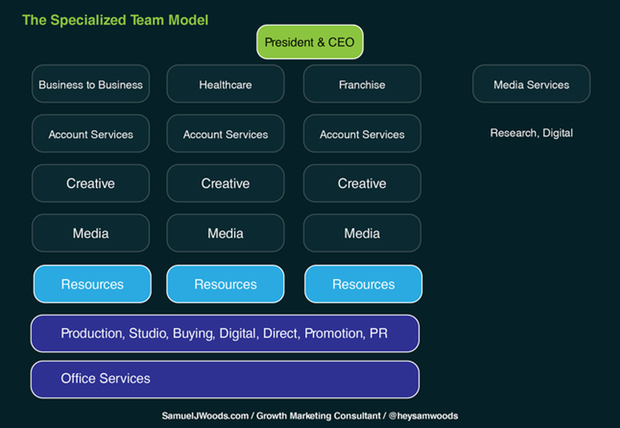
Factors for it to be successful:
- Maintaining focus on specialization.
- Balancing the centralizing an de-centralizing of functions.
- Recognize and placement of talent.
When to use it:
- You serve complex markets and industries.
- You actually have specialize talent readily available.
Issues this structure addresses:
- Using only the resources needed.
- Leadership priorities are clearly defined.
- Consistency in work produced and approach.
Potential problems created by this structure:
- Usually, you’ll need to develop proprietary capabilities.
- Heavy investment in talent and leadership.
- Effectively utilizing shared resources and avoiding monopolization.
4. The Delivery Team Model
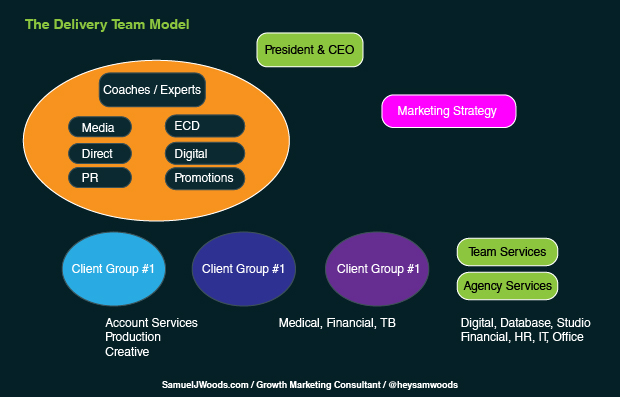
Factors for it to be successful:
- Aligning and matching work with capabilities.
- Balancing your executional orientation with strategy.
When to use it:
- You have well-defined work and clients.
- The “numbers” make sense, i.e. tight economics.
- You need quick turnaround on high volume.
Issues this structure addresses:
- Your client is placed in the center.
- Allows for “Intrapreneurs” to flourish.
- Priorities are in focus, and politics reduced.
Potential problems created by this structure:
- Keeping specializations and career in focus.
- Utilization of resources and cross-fertilization.
5. The “Virtual” Team Model
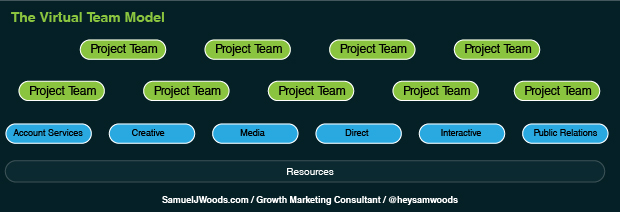
Factors for it to be successful:
- Tools and environments will matter and compensate for lack of other elements.
- You need motivated, quality talent.
- Your delivery mechanisms need to allow for flexibility.
When to use it:
- You have access to exceptional sub-contractors.
- You’re using short sprints and high-effort, high-impact workflows.
Issues this structure addresses:
- The need for a fluid, energetic environment.
- The need for spontaneity, autonomy, and flexibility.
- Leadership is base on performance and merit.
Potential problems created by this structure:
- Follow-through on execution can be a problem.
- Resource availability might be strained and cause conflict.
- Agency economics need to be tightly managed.
The objective is always to create a running operation within and with a marketing team that allows for experimentation, growth strategies to be implemented.
Often, you’ll need a revision, or at least a translation, of a company’s strategic vision into internal systems, processes, practices, people, and structures to be able to achieve the vision.
See? It always comes back to vision when you’re dealing with making adjustments and changes to how your marketing team pursues growth.
Priming The Pumps For Re-Modeling Your Marketing Team
The core takeaway: your growth marketing strategy, systems, and processes determine the team structure and function.
When you build a growth team, or re-work your current marketing, you’re changing the way you work.
Because of that, you’re in need of re-organizing.
Improving profitability, developing a new systems plan, streamlining productivity, moving into a team-based environment, and so on, will all be addressed.
You need to translate your strategic growth vision into a organizational structure, systems, processes, skills, and technology needed to actually move from vision to reality.
So, what should a growth team look like? You only form one when you’re at product/market fit and are ready to scale your growth.
If you’re a startup, you do not need a “growth team”. Maybe a “growth hacker”, but the focus there is marketing for traction, which is different than growth.
More on that in part 2.

